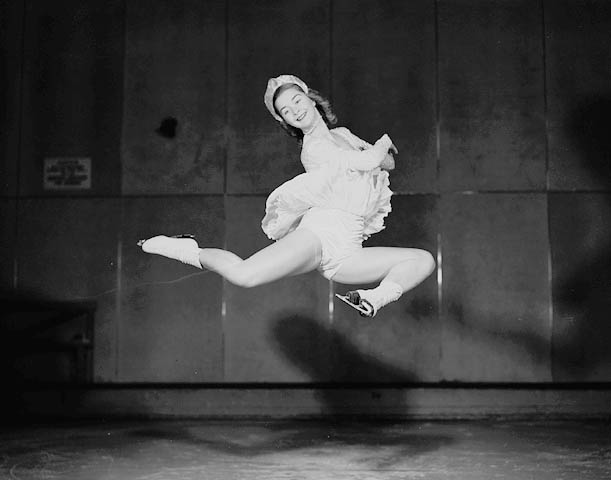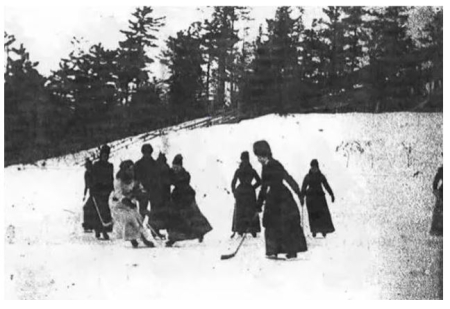It was just coincidental, though perhaps entirely appropriate, that the presentation on March 23, 2024, at the Main branch of the Ottawa Public Library titled “Ottawa Women on Ice” took place against the backdrop of the World Figure Skating Championships in Montreal and a game between Ottawa and Toronto in the newly-formed Professional Women’s hockey League. James Powell, the speaker that afternoon, told an enthusiastic audience of 44 about Ottawa’s lengthy and often glorious history in women’s hockey and the achievements of two Ottawa women in figure skating—Barbara Ann Scott and Elizabeth Manley. James is a frequent speaker at HSO and community events; runs the blog “Today in Ottawa’s History” and was awarded the Historical Society of Ottawa’s Story Teller award in 2023 for his fine work in telling Ottawa’s history.
Few probably realize that women’s hockey started in Ottawa when Isobel Stanley, the daughter of Lord Stanley, Canada’s Governor General from 1888-1893, strapped on a pair of skates in 1889 and stick-handled around other Rideau Hall women in the first ever women’s hockey game in an outdoor rink at Government House. That same year, Isobel Stanley and other ladies from Rideau Hall triumphed over a team from the Rideau Rink in the first ever women’s hockey game covered by the press. With a vice-regal stamp of respectability helping to alleviate concerns about the appropriateness of women playing hockey, women’s hockey teams multiplied in the Ottawa-Hull area and throughout the Ottawa Valley, this included the “Alphas” of New Edinburgh, the Rideau Rink Ladies, the Vestas of Hull, and the Cliffside Ladies, also known as the “Busy Bees,” who claimed the first city championship when they defeated the Sandy Hill Ladies in 1908. Away games by Ottawa teams to play teams in Smiths Falls and Cornwall were chaperoned to keep the young ladies in line. Long skirts and tam-o-shanters were the uniforms of the day.
Women’s hockey received a major boost with the outbreak of World War I. With the men away, scarce rink time opened up for women. As well, rink owners looked for new ways to rent out the ice and fill seats. In Montreal, a women’s hockey league brought in thousands of fans attracted by the high calibre of the game. Many also came to see the Cornwall Victorias, led by their superstar Albertine Lapensée, also known as the “Miracle Maid” and “Étoile des étoiles”, and the Ottawa Alerts, the formidable team from the Capital. Lapensée was likely the first professional female hockey player.
The origins of the Ottawa Alerts are obscure but the team, captained by Edith Anderson burst onto the scene in 1916. Their most fierce local rivals were the Westboro Pats led by Tena Turner. The two teams fought for the city championship in 1917 with the Alerts prevailing in a two-game, total goal series. The Alerts then defeated the Westerns, Montreal’s hockey champions, to win the Dey Cup.
The Ottawa Alerts joined the Ladies’ Ontario Hockey Association (LOHA) in 1922 when the league formed, bringing together fifteen teams from across the province. Behind their star player, the all-round athlete Shirley Moulds, the team won two consecutive championships in 1923 and 1924. The Alerts went into decline when Moulds moved to the Ottawa Rowing Club as the team’s captain. The “Scullers” defeated the Alerts to take the city championship in 1927, and subsequently won the provincial title, defeating the Toronto Pats.
The Great Depression was the death knell for women’s hockey in Ottawa and in Canada more generally. Both the Alerts and the Scullers disappeared into history as did the LOHA and the Dominion Women’s Amateur Hockey Association, the latter founded in 1933. By the onset of World War II, organized women’s hockey was no more. However, before the end came, the 1930s saw the emergence of the most powerful women’s hockey team of the era—the Preston Rivulettes. During its short career, the team lost only two out of 350 games.
Women’s hockey didn’t re-emerge as a significant sport until the 1970s. However, leading the way in the post-war era was ten-year old Dee Dee Hamilton who stepped into the breach in 1956 when the goalie on her brother’s team, the St. Pat’s, couldn’t play in a game hosted by Ottawa’s Cradle Hockey League. So good was Dee Dee that she played in the 1957 All-Star Game. For two years, she was the only girl amidst 800 boys in the league.
With the establishment of a new professional women’s hockey league at the beginning of 2024 with a team in Ottawa, it is possible that the old “Alerts” name may be revived. In the lead-up to the formation of the league, a number of trademarks were registered for potential names of its clubs. In addition to such monikers as the Toronto Torch and the Montreal Echo was the Ottawa Alert.
 Credit: Frank Royal / National Film Board of Canada / Library and Archives Canada / PA-112691.Switching to figure skating, James traced the career of Canada’s sweetheart, Barbara Ann Scott, from winning the Canadian Junior Figure Skating crown in 1940 to taking the gold medal at the 1948 Winter Olympics held in St. Moritz, France. But it didn’t come easily for Scott. Her success required long hours of practice and hard work, training at the Minto Skating Club, the skating club founded by Lord and Lady Minto in 1903. James showed a short film of her performance at St Moritz which displayed her grace and form as a gold-medal figure skater.
Credit: Frank Royal / National Film Board of Canada / Library and Archives Canada / PA-112691.Switching to figure skating, James traced the career of Canada’s sweetheart, Barbara Ann Scott, from winning the Canadian Junior Figure Skating crown in 1940 to taking the gold medal at the 1948 Winter Olympics held in St. Moritz, France. But it didn’t come easily for Scott. Her success required long hours of practice and hard work, training at the Minto Skating Club, the skating club founded by Lord and Lady Minto in 1903. James showed a short film of her performance at St Moritz which displayed her grace and form as a gold-medal figure skater.
Returning to Ottawa as a national hero after the Olympics, some 70,000 fans met her train at Union Station, where she was personally greeted by Prime Minister Mackenzie King and Ottawa Mayor Stanley Lewis. Schoolchildren were given a half-day holiday. In honour of her victory, Ottawa gave Scott a car with the licence plate 48-U-1. She then started her professional career, ousting Sonja Henning, her arch rival, from the Hollywood Ice Review. In 1950, the most desired Christmas gift was a Barbara Ann Scott doll, complete with white figure skates, costing a steep $5.95.
Scott retired from skating in 1955 when she married Tom King. In 1991, she was appointed to the Order of Canada. Scott passed away in 2012 in Florida at age 84. She bequeathed her sports memorabilia to the City of Ottawa.
James ended his presentation with the career of another daughter of Ottawa, Elizabeth Manley, who won the silver medal at the 1988 Olympics in Calgary. Like Scott forty years earlier, it took years of grit and determination to achieve perfection—and that was what she achieved in her long program in Calgary. Although she came first in that section of the competition, she lost overall by a hair to East Germany’s, Katerina Witt. At the end of a short video of her long program, people in the library auditorium broke out into applause, indicative of the power of Manley’s performance thirty-four years ago. Manley was appointed to the Order of Canada in 1988, and, following her skating career, has devoted considerable time to charity.
In the usual question and answer section that followed, three descendants of Shirley Moulds, the Ottawa Alerts’ star player, identified themselves in the audience. They indicated Moulds had been a very private person who had not talked about her hockey career. Her niece said that it was only after Shirley’s death that she became aware of her prowess as a hockey player. The only thing she knew was that Aunt Shirley was a great bowler! Shirley Moulds’ great-nephew was instrumental in Moulds being named to Ottawa’s Sports Hall of Fame in 2010.






